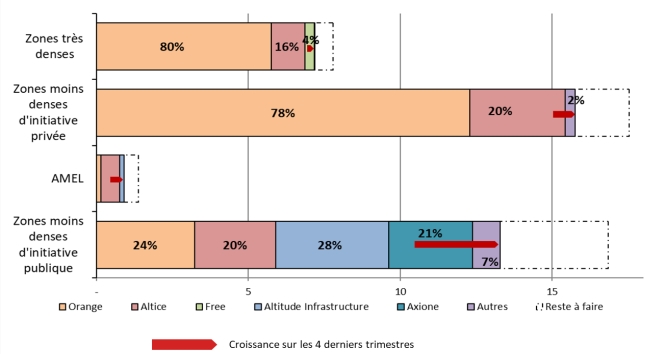Optical fiber: the pace of deployments is running out of steam in France


Arcep is sounding the alarm signal. One more time. After having already noticed a slowdown during the first half of the year, the telecom regulatory authority notes that the overall pace of fiber optic deployments continued to decrease this summer. During the third quarter, an additional 825,000 premises were made connectable, which is 25% less than in the same period of the previous year.
During these three months, the optical fiber coverage has thus increased by only one point to reach 84%. As of September 30, nearly 8 million premises remained to be made connectable out of the 43.9 million identified. Could this shortness of breath call into question the presidential objective of “fibering” the entire territory by the end of 2025? Already, the government has had to put water in its wine by negotiating an agreement with Orange stating in fact that the 100% will not be reached by this deadline.

City fiber and field fiber
In the field, this slowdown does not apply equally according to Arcep’s high and very high speed observatory. Paradoxically, it affects more the big cities which were nevertheless the first to be fibered. In these very dense areas (ZTD), the pace of deployment has literally collapsed with less than 24,000 premises connected over a quarter,” that is a division by three compared to the same period of the previous year. » Thus, Montpellier stagnates with a coverage rate of 85%.
Conversely, deployments in rural areas, concerned by Public Initiative Networks (PIRS), are progressing strongly with 565,000 new connectable premises. Similarly, the areas concerned by the “AMEL” (calls for demonstrations of local commitments), have seen more than 97,000 premises made connectable, ” either the second best quarter “since the observatory has existed.
President of Avicca, an association of communities engaged in digital technology, its president and senator LR of Ain, Patrick Chaize recently quipped about this situation. « A new digital divide is emerging, which has the strange particularity of having rural areas better covered than urban areas, as is already the case in 31 departments”.

The special case of the AMII
Between, the rural fabric and the large agglomerations, we find the moderately dense areas called “AMII” for “call for manifestation of investment intention”, whose situation is no better. Only 139,000 premises were made connectable, a decrease of 20% over one year.
As a reminder, these AMII are the subject of a dispute between Arcep and Orange. For not having respected its deployment commitments in medium-sized cities, such as Bourg-en-Bresse, Castres, Orgeval, Vichy or Gap, the incumbent operator received a penalty of 26 million euros by the telecom gendarme. The latter informs that about 90% of the premises of the municipalities on which Orange has committed are connectable compared to about 95% for SFR.
Will the deal reached between the executive and Orange make it possible to straighten out the bar? Marie-Amandine Stévenin doubts it. In a free forum, the president of the UFC-Que Choisir consumer association estimates what this agreement ” act a virtual renunciation by the government that all consumers have optical fiber by the end of 2025 ». « Rather than negotiating falsely ambitious agreements with Orange, the government would do better to allow all consumers to benefit from a real enforceable right to superfast broadband”, she estimates.
This universal right was mentioned a year ago by Jean-Noël Barrot. The Minister delegate in charge of the digital transition and telecommunications was then considering the possibility of universal access to very high speed broadband for all, to ” an affordable price “and with a guaranteed speed of 30 Mb/s. Since then, we haven’t heard about it anymore.








